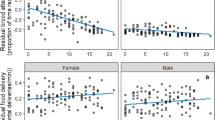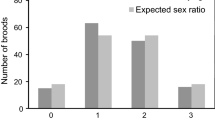Abstract
In polygynous and sexually dimorphic mammals, parents may be expected to bias their investment towards sons because variation in reproductive success is usually higher among males than among females. Moreover, male reproductive success often depends on adult body size, which, in turn, may depend on the level of parental investment. We therefore predicted that in the grey seal (Halichoerus grypus), a polygynous and sexually dimorphic phocid seal, females should invest more in individual sons than in individual daughters. We found that male pups were born heavier than female pups, but that the growth rates and suckling behaviour were similar for the two sexes. The growth rates and the birth weights were not correlated for the pups of either sex. Mothers did not behave differentially towards offspring of the two sexes, except that mothers of male pups spent more time in visual contact with their pups. Male and female pups had similar activity levels and begged at similar rates. We argue that reports of equal expenditure on the two sexes can be accepted as evidence of equal investment, provided that three assumptions are fulfilled. First, parental care must be costly to the parent. Second, energy expenditure must be the most important component of parental investment. Third, there must be no negative correlation between maternal body condition and the ratio of sons to daughters produced. We argue that these assumptions are met in our study, and that our results provide evidence of equal maternal investment in the sexes in grey seals.
Similar content being viewed by others
References
Anderson SS, Fedak MA (1985) Grey seal males: energetic and behavioural links between male size and sexual success. Anim Behav 33:829–838
Anderson SS, Fedak MA (1987) Grey seal, Halichoerus grypus, energetics: females invest more in male offspring. J Zool Lond 211:667–679
Anderson SS, Burton RW, Summers CF (1975) Behaviour of grey seals (Halichoerus grypus) during a breeding season at North Rona. J Zool Lond 177:179–195
Boness DJ (1979) The social system of the grey seal, Halichoerus grypus (Fab.), on Sable Island, Nova Scotia. PhD thesis, Dalhousie University, Halifax, Nova Scotia
Bowen WD, Stobo WT, Smith SJ (1992) Mass changes of grey seal Halichoerus grypus pups on Sable Island: differential maternal investment reconsidered. J Zool Lond 227: 607–622
Boyd JM, Campbell RN (1971) The grey seal (Halichoerus grypus) at North Rona, 1959–1968. J Zool Lond 164:469–512
Bryden MM (1972) Growth and development of marine mammals. In: Harrison RJ (ed) Functional anatomy of marine mammals, vol 1. Academic Press, London, pp 1–79
Byers JA, Bekoff M (1990) Inference in social evolution theory: a case study. In: Bekoff M, Jamieson D (eds) Interpretation and explanation in the study of animal behaviour, vol 2: explanation, evolution, and adaptation. Westview, Boulder, pp 84–97
Byers JA, Moodie JD (1990) Sex-specific maternal investment in pronghorn, and the question of a limit on differential provisioning in ungulates. Behav Ecol Sociobiol 26:157–164
Campagna C, Le Boeuf BJ, Lewis M, Bisioli C (1992) Equal investment in male and female offspring in southern elephant seals. J Zool Lond 226:551–561
Clark AB (1978) Sex ratio and local resource competition in a prosiminian primate. Science 201:163–165
Clutton-Brock TH (1991) The evolution of parental care. Princeton University Press, Princeton
Clutton-Brock TH, Albon SD, Guinness FE (1981) Parental investment in male and female offspring in polygynous mammals. Nature 289:487–489
Clutton-Brock TH, Guinness FE, Albon SD (1982) Red deer: behaviour and ecology of two sexes. University of Chicago Press, Chicago
Clutton-Brock TH, Albon SD, Guinness FE (1984) Maternal dominance, breeding success, and birth sex ratios in red deer. Nature 308:358–360
Clutton-Brock TH, Albon SD, Guinness FE (1988) Reproductive success in male and female red deer. In: Clutton-Brock TH (ed) Reproductive success. University of Chicago Press, Chicago, pp 325–343
Daniel C, Wood FS (1971) Fitting equations to data. Wiley, New York
Duncan P, Harvey PH, Wells SM (1984) On lactation and associated behaviour in a natural herd of horses. Anim Behav 32:255–263
Fedak MA, Anderson SS (1982) The energetics of lactation: accurate measurements from a large wild mammal, the grey seal (Halichoerus grypus). J Zool Lond 198:473–479
Fogden SCL (1971) Mother-young behaviour at grey seal breeding beaches. J Zool Lond 164:61–92
Gauthier D, Barrette C (1985) Suckling and weaning in captive white-tailed and fallow deer. Behaviour 94:128–149
Hewer HR (1974) British seals. Collins, Glasgow
Kovacs KM (1986) Maternal investment and early behavioural development in the harp (Phoca groenlandica) and grey seals (Halichoerus grypus). PhD thesis, University of Guelph, Guelph, Ontario
Kovacs KM (1987) Maternal behaviour and early behavioural ontogeny of grey seals (Halichoerus grypus) on the Isle of May, UK. J Zool Lond 213:697–715
Kovacs KM, Lavigne DM (1986a) Growth of grey seal Halichoerus grypus neonates: differential maternal investment. Can J Zool 64:1937–1943
Kovacs KM, Lavigne DM (1986b) Maternal investment and neonatal growth in phocid seals. J Anim Ecol 55:1035–1051
Kretzmann MB, Costa DP, Le Boeuf BJ (1993) Maternal energy investment in elephant seal pups: evidence for sexual equality? Am Nat 141:446–480
Laws RM (1959) Accelerated growth in seals with special reference to the Phocidae. Norsk Hvalfangst-tid 9:425–452
Le Boeuf BJ (1991) Pinniped mating systems on land, ice and in the water: emphasis on the Phocidae. In: Renouf D (ed) Behaviour of pinnipeds. Chapman and Hall, London, pp 45–65
Le Boeuf BJ, Reiter J (1988) Lifetime reproductive success in northern elephant seals. In: Clutton-Brock TH (ed) Reproductive success. University of Chicago Press, Chicago, pp 344–362
Le Boeuf BJ, Condit R, Reiter J (1989) Parental investment and the secondary sex ratio in northern elephant seals. Behav Ecol Sociobiol 25:109–117
Martin P, Bateson P (1986) Measuring behaviour: an introductory guide. Cambridge University Press, Cambridge
Maynard Smith J (1980) A new theory of sexual investment. Behav Ecol Sociobiol 7:247–251
McCann TS, Fedak MA, Harwood J (1989) Parental investment in southern elephant seals, Mirounga leonina. Behav Ecol Sociobiol 25:81–87
Norusis MJ (1990) SPSS advanced statistics user's guide. SPSS Inc., Chicago
Reiter J (1984) Studies of female competition and reproductive success in the northern elephant seal. PhD thesis, University of California, Santa Cruz.
Reiter J, Stinson NL, Le Boeuf BJ (1978) Northern elephant seal development: the transition from weaning to nutritional independence. Behav Ecol Sociobiol 3:337–367
Smiseth PT, Lorentsen S-H (1995) Behaviour of female and pup grey seals Halichoerus grypus during the breeding period at Froan, Norway. J Zool Lond 235
Stamps JA (1990) When should avian parents differentially provision sons and daughters? Am Nat 135:671–685
Trivers RL (1972) Parental investment and sexual selection. In: Campbell B (ed) Sexual selection and the descent of man. Heinemann, London, pp 136–179
Trivers RL, Willard DE (1973) Natural selection of ability to vary the sex ratio of offspring. Science 179:90–92
Wiig Ø (1985) Morphometric variation in the hooded seal (Cystophora cristata). J Zool Lond 206:497–508
Willson MF, Pianka EF (1963) Sexual selection, sex ratio and mating system. Am Nat 97:405–407
Zar JH (1984) Biostatistical analysis, 2nd edn. Prentice-Hall, Englewood Cliffs
Author information
Authors and Affiliations
Rights and permissions
About this article
Cite this article
Smiseth, P.T., Lorentsen, SH. Evidence of equal maternal investment in the sexes in the polygynous and sexually dimorphic grey seal (Halichoerus grypus). Behav Ecol Sociobiol 36, 145–150 (1995). https://doi.org/10.1007/BF00177790
Received:
Accepted:
Issue Date:
DOI: https://doi.org/10.1007/BF00177790




